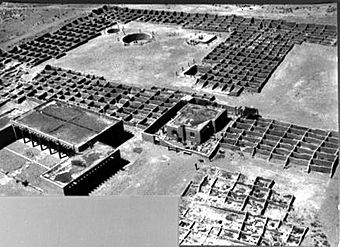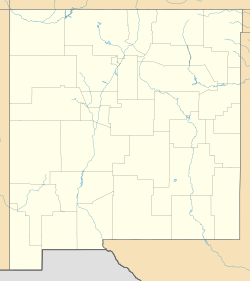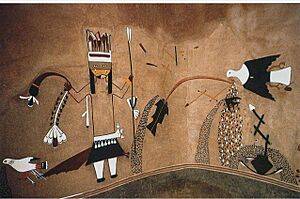Coronado Historic Site facts for kids
|
Kuaua Ruin
|
|

Aerial view of Kuaua ruins, circa 1940
|
|
| Nearest city | Bernalillo, New Mexico |
|---|---|
| Area | 5.7 acres (2.3 ha) |
| Built | 1939 |
| Architect | John Gaw Meem |
| Architectural style | Pueblo |
| NRHP reference No. | 76001199 |
Quick facts for kids Significant dates |
|
| Added to NRHP | January 1, 1976 |
The Coronado Historic Site is a special place in New Mexico. It's home to the ancient village of Kuaua, built by the Tiwa people. This site is part of the Museum of New Mexico system, which helps protect important historical places.
You can find it near Bernalillo, about one mile west of the town, and 16 miles north of Albuquerque.
Contents
The Story of Kuaua Pueblo
The most famous part of the Coronado Historic Site is Kuaua Pueblo. In the Tiwa language, "Kuaua" means "evergreen." This ancient village, or pueblo, was first settled around the year 1325. People lived there for over 200 years, but the village was abandoned by the late 1500s.
The Coronado Historic Site was the very first archaeological site in New Mexico to open its doors to the public. It officially opened on May 29, 1940. This opening was part of a big celebration called the Cuarto Centenario. This event marked 400 years since Francisco Vásquez de Coronado first arrived in New Mexico.
Coronado and his group camped near this area between 1540 and 1542. Kuaua was one of several Tiwa-speaking pueblos in the region at that time. It's believed that the village was abandoned because of Coronado's arrival and the difficult times that followed, including the Tiguex War in 1541.
Uncovering Ancient Secrets
Archaeologists worked hard to uncover the ruins of Kuaua Pueblo. A team led by Edgar Lee Hewett and Marjorie F. Tichy (who later became Marjorie Lambert) excavated the site from 1934 to 1939.
Their work showed that the village grew from south to north over its 300-year history. They also found six kivas. Kivas are special rooms used by Pueblo people for ceremonies and community gatherings. These kivas were built in different shapes, including round, square, and rectangular.
One of the most amazing discoveries was a collection of ancient murals. These paintings were found in a square kiva in the southern part of the pueblo. These murals were created before 1541, before Europeans arrived. They are some of the best examples of Native American art found anywhere in North America!
Visiting the Coronado Historic Site
The visitor center at Coronado Historic Site was designed by a famous architect from the Southwest named John Gaw Meem. Inside, you can see fourteen of the restored kiva murals. There are also many artifacts from the Pueblo Indian and Spanish Colonial periods.
You can walk along an interpretive trail that winds through the ancient ruins. This trail also goes along the west bank of the beautiful Rio Grande river.
See also




